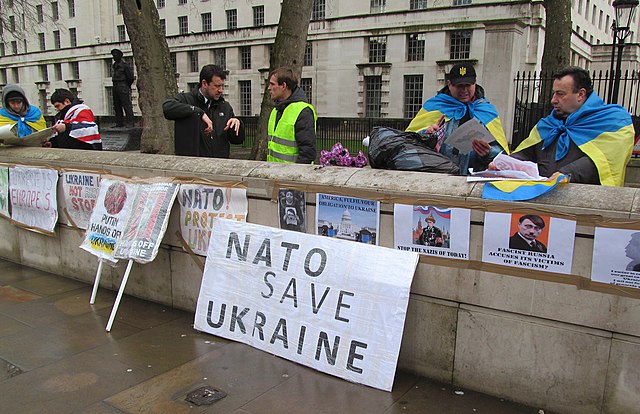
Please Follow us on Gab, Minds, Telegram, Rumble, Gab TV, GETTR
Over the years, numerous Ukrainian and international analysts and politicians have predicted “an imminent Russian attack” on Western-backed Ukraine. Now Russia and Belarus seem to have adopted a similar strategy – accusing NATO of planning to open military bases in the Eastern European country.
Ever since Ukraine and the Russia-sponsored, self-proclaimed Donetsk People’s Republic and Lugansk People’s Republic signed a ceasefire agreement in 2015 – a deal that effectively ended offensive military operations in the coal-rich Donbass region, although positional warfare still goes on – military and political experts have been warning a new round of full-scale confrontation is just a matter of time. To this day, however, neither Ukraine nor the Donbass republics have captured one square meter of new territory. Kyiv often accuses Moscow of planning to launch a ground invasion of the former Soviet republic, and in the spring of 2021 both Russia and Ukraine were building up their forces not only in the areas close to the Donbass, but also near Crimea. Still, there was no escalation, despite media hysteria.
Today the situation on Russo-Ukrainian border, as well as on the border between Ukraine and Belarus, is very clam, but still Belarusian President Alexander Lukashenko warns that “close attention should be paid to the Ukrainian section”.
“NATO is setting up actual bases under the guise of training centers. The United States is setting up bases in Ukraine. It is clear that we have to respond to it”, said Lukashenko, pointing out that he agreed with Russian President Vladimir Putin that “some actions need to be taken”.
The Kremlin, on the other hand, warned that any expansion of NATO military infrastructure in Ukraine would cross one of Putin’s “red lines”. When asked what Moscow and Minsk can do in response to such a move by NATO, Kremlin spokesman Dmitry Peskov noted it would be “actions aimed at ensuring security of the two states.” Earlier this year, the Russian leader said that Moscow would determine where its red lines lay in each specific case. In other words, NATO bases in Ukraine could very well be one of Russia’s “red lines”, at least in theory. In reality, however, NATO is already in Ukraine. The Eastern European country has held numerous military exercises with the Alliance on Ukrainian territory. British instructors are reportedly training Ukrainian troops, and Kyiv already purchased US-made Javelin anti-tank missile systems, as well as Turkish-made Bayraktar drones. Russia, for its part, did not do anything to prevent such activities. Thus, it remains unclear if a NATO presence in Ukraine is really a headache for the Kremlin.
From a purely military perspective, it does not make much difference if NATO missiles are deployed in Estonia, some 160 kilometers (100 miles) from Saint Petersburg, or in Eastern Ukrainian city of Kharkov, 340 kilometers (210) miles from the southwestern Russian city of Voronezh. NATO is already on the Russian borders, and Ukraine is heavily in the Western geopolitical orbit. That, however, does not mean that NATO intends to invade Russia. In spite of harsh warmongering and fearmongering rhetoric, the two sides will unlikely fight a direct war. Proxy conflicts however, like the one in the Donbass, are entirely possible.
For the foreseeable future, the West will keep using Ukraine – in a rather limited way – as an instrument against Russia. Moscow will continue to use its proxies in the Donbass as a tool against Kyiv. Any form of invasion, or full-scale military confrontation, seems extremely improbable at this point. From the perspective of some very influential energy lobbies close to the Kremlin, capturing Ukrainian territory would mean feeding and providing energy to millions of people. Given that energy is becoming expensive and scarce, Russia will unlikely get involved in such an adventure. Instead, Moscow is focusing on supplying natural gas to Europe through pipelines that bypass Ukraine, namely NordStream 2 and TurkStream. Kyiv, for its part, argues that hydrogen energy could eventually replace Russian natural gas. According to reports, four companies from Germany, Slovakia, the Czech Republic and Ukraine are joining forces to build a hydrogen pipeline through Central Europe, although it will takes years, if not decades, until such a project becomes fully operational. Meanwhile, Ukraine, as well as most of Europe, will keep facing increasing gas prices. Ukraine has become the only European state to abandon its long-term gas contract with Russia’s energy giant Gazprom, and is now forced to buy Russian natural gas at a market price that has reached more than $1000 per cubic meter. Thus, from the Kremlin’s perspective, invading such a country would be an unnecessary expense. Selling it energy at extremely high prices is certainly more profitable.
You Won’t Get Anywhere Else What You Get From CDMedia! Donate!
- Telegram Messenger Blocks Navalny Bot During Russian Election
- Fire In the Fire Department – Who Will Save Us From Communism?

